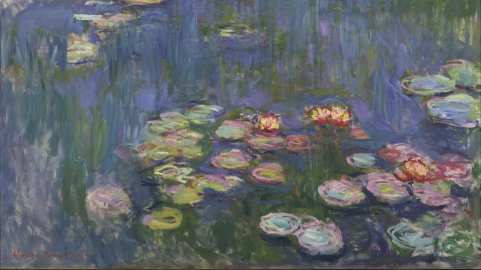
In some poems the speaker feels closer to you than in others. I’m not sure why. It may have as much to do with the reader as the speaker, but it’s also something about the poet’s ‘voice’ I think: their approach to rhyme, choice of syntax, sense of rhythm, even the subject matter. The speaker’s mouth just seems closer to your ear and gives you – even without hearing the work read out – a stronger sense of a character standing there behind the poem. This is not a dramatic character but a personality – either the poet’s own or their creation’s – which fully inhabits the words. Some of Simon Armitage’s poetry has this quality I think, and Sharon Olds’, in a very different way, often has it too. Paul Stephenson’s Selfie with Waterlilies (Paper Swans) is a pamphlet of such poems, although I’m not suggesting it bears any other similarities to either of these two poets’ work.
Stephenson takes a more-than-usual delight in language, and this comes through in all sorts of ways: his use of internal and half-rhyme, imaginative repetition, knowingly deployed cliché, shaped poems, punning and other word-play; and it seems to me that he uses this delight as a distancing mechanism, a way of stepping back from the objects of his poems in order to take a clearer look. Perhaps it is this stepping back that brings him a step closer to us. It’s a technique similar to that employed by comedians who use humour to dissect and analyse the world; but Stephenson’s aim is not to amuse, although there are funny poems like ‘The Apprentice’, which memorably teases barrow-boy-cum-millionaire Alan Sugar by ending every line of an open letter to him with the word beetroot. His main purpose here is I think to use language as a distorting lens which emphasises features that might otherwise be missed, features of his parents and their infirmities, his childhood, and his relationship with continental Europe, Russia and Turkey. And of course, the sense of delight in language works in particular contrast to the sadness of the poems which deal with death in the family.
There is a lot of travel in these poems. The speaker takes a taxi across the Bosphorus in ‘Turkish Delight’, before travelling home to see a dying relative (whom we assume to be this father from subsequent poems, though interestingly this is never directly said); he takes a trip in a car with his family only for his father to refuse to get out when they arrive (‘Where are we going?’); he drives down the sleepily repeated “motorways of France” (‘Autoroutes’); he blurs weather and security at Houston Airport (‘Going through’); and finally he has fun with airline safety instructions by putting them into an imperfect online translator: “So listen hard, belt up and fear the worst safely” (‘Waistcoat of Life’). These poems not only reflect a globalised twenty-first century, they also create a sense of personal dislocation, a jitteriness, an inability, perhaps, to settle down; here the speaker’s movement in the world reflects a life thrown into turmoil by death. But the travel in these poems is juxtaposed starkly with the stillness of poems like ‘Womb’ (a sonnet of single word images surrealistically building a portrait of a child in the womb), and ‘Selfie with Waterlilies’ (a double page of two waterlily shapes made up of phrases beginning with a self-centred me). So, at the heart of the pamphlet there is both movement and stasis; maybe it’s the reality of the former and the yearning for the latter. For me, the speaker feels tired in the ‘still’ poems, like the tiredness we all feel when we experience inescapable grief. Stephenson knows that there are times when grammar, punctuation and syntax should keep a firm hold of a poem, and other times (as in ‘My Father’s Food’) when the imagery can take over and lead the mechanics of the language.
‘Deathflake’, perhaps more than any other poem, carries the speaker’s playfulness somewhere darker, using the simple but effective idea of transposing the words “death” and “snow” in various phrases, clichés and collocations, creating new, unusual and sometimes unsettling images (“He snowed heavily in his sleep/Death White. Snow duty.”). There are hints too, I think, towards problems of both physical and mental health in the family of these poems, and disillusionment along with the love, a bitterness which is vaguely alluded to throughout and then begins to head towards some kind of catharsis in the final poem (‘Appeasement’), which picks up the /athe/ sound in “swathe” and plays with it almost like a kitten with a ball of string before the speaker finally changes tone and addresses his family directly: “Mother, father, brother,/you know I don’t loathe you/though indeed at times I’ve seethed”.
Because family and the speaker’s youth play such central roles, it also feels like there is more to be said than was possible in twenty-three poems, as though we are reading a selection of stories from a much longer text. There are unanswered but intriguing questions at the end of this enjoyable and thought-provoking pamphlet, and I hope we’ll soon get to read a full collection from Stephenson for some answers to those questions. He has, with this pamphlet and its predecessor The Days That Followed Paris, begun the process of creating a strong poetic voice which knows both what it wants to say and how it wants to say it; and because it has this quality of proximity to the reader (this reader anyway), it feels like a voice to return to and hear again.
Selfie with Waterlilies is published by Paper Swans Press and is available here.
The painting above is a detail of Water Lilies by Claude Monet, National Museum of Western Art, Tokyo.

